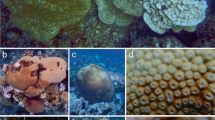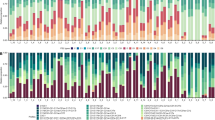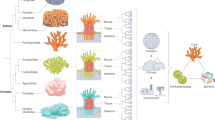Abstract
Coral bleaching is the disruption of the symbiosis between the coral host and its endosymbiotic algae. The prevalence and severity of the disease have been correlated with high seawater temperature. During the last decade, the major hypothesis to explain coral bleaching is that high water temperatures cause irreversible damage to the symbiotic algae resulting in loss of pigment and/or algae from the holobiont. Here, we discuss the evidence for an alternative but not mutually exclusive concept, the microbial hypothesis of coral bleaching.
Similar content being viewed by others
Log in or create a free account to read this content
Gain free access to this article, as well as selected content from this journal and more on nature.com
or
References
Ainsworth TD, Fine M, Roff G, Hoegh-Guldberg O . (2008). Bacteria are not the primary cause of bleaching in the Mediterranean coral Oculina patagonica. ISME J 2: 67–73.
Ben-Haim Y, Rosenberg E . (2002). A novel Vibrio sp. pathogen of the coral Pocillopora damicornis. Mar Biol 141: 47–55.
Ben-Haim Y, Zicherman-Keren M, Rosenberg E . (2003). Temperature-regulated bleaching and lysis of the coral Pocillopora damicornis by the novel pathogen Vibrio coralliilyticus. Appl Envir Microbiol 69: 4236–4242.
Bourne D, Iida Y, Uthicke S, Smith-Keune C . (2008). Changes in coral-associated microbial communities during a bleaching event. ISME J 2: 350–363.
Brown BE . (1997). Coral bleaching: causes and consequences. Coral Reefs 16: S129–S138.
Cervino JM, Hayes RL, Goreau TJ, Smith GW . (2004a). Zooxanthellae regulation of yellow blotch/band and other coral diseases contrasted with temperature related bleaching: in situ destruction vs expulsion. Symbiosis 37: 63–85.
Cervino JM, Hayes RL, Honovich M, Goreau TJ, Jones S, Rubec PJ . (2003). Changes in zooxanthellae density, morphology and mitotic index in hermatypic corals and anemones exposed to cyanide. Mar Pollut Bull 46: 573–586.
Cervino JM, Hayes RL, Polson SW, Polson SC, Goreau TJ, Martinez RJ et al. (2004b). Relationship of Vibrio species infection and elevated temperatures to yellow blotch/band disease in Caribbean corals. Appl Environ Microbiol 70: 6855–6864.
Davy JE, Patten NL . (2007). Morphological diversity of virus-like particles within the surface microlayer of scleractinian corals. Aquat Microb Ecol 47: 37–44.
Fine M, Banin E, Israely T, Rosenberg E, Loya Y . (2002). Ultraviolet (UV) radiation prevents bacterial bleaching of the Mediterranean coral Oculina patagonica. Mar Ecol Progr Ser 226: 249–254.
Galloway SB, Work TM, Bochsler VS, Harley RA, Kramarsky-Winter E, McLaughlin SM et al. (2007). Coral Disease and Health Workshop: Coral Histopathology II. NOAA Technical Memorandum NOS NCCOS 56 and NOAA Technical Memorandum CRCP 4. National Oceanic and Atmospheric Administration, Silver Spring, MD. pp 10–11.
Gleason DF, Wellington GM . (1993). Ultraviolet radiation and coral bleaching. Nature 365: 836–838.
Goreau TF . (1964). Mass expulsion of zooxanthellae from Jamaican reef communities after Hurricane Flora. Science 145: 383–386.
Harel M, Ben-Dov E, Rasoulouniriana D, Siboni N, Kramarsky-Winter E, Loya Y et al. (2008). A newThraustochytrid, strain Fng1, isolated from the surface mucus of the hermatypic coral Fungia granulosa. FEMS Microbiol Ecol 64: 378–387.
Jokiel PL . (2004). Temperature stress and coral bleaching. In: Rosenberg E, Loya Y (eds). Coral Health and Disease. Springer-Verlag: New York. pp 401–425.
Jokiel PL, Coles SL . (1990). Response of Hawaiian and other Indo-Pacific reef corals to elevated temperature. Coral Reefs 8: 155–162.
Jones RJ, Hoegh-Guldberg O, Larkum AWD, Schreiber U . (1998). Temperature-induced bleaching of corals begins with impairment of the CO2 fixation mechanism in zooxanthellae. Plant Cell Environ 21: 1219–1230.
Koren O, Rosenberg E . (2006). Bacteria associated with mucus and tissues of the coral Oculina patagonica in summer and winter. Appl Environ Microbiol 72: 5254–5259.
Kramarsky-Winter E, Harel M, Siboni N, Ben Dov E, Brickner I, Loya Y et al. (2006). Identification of a protist–coral association and its possible ecological role. Mar Ecol Progr Ser 317: 67–73.
Kushmaro A, Kramarsky-Winter E . (2004). Bacteria as a source of coral nutrition. In: Rosenberg E, Loya Y (eds). Coral Health and Disease. Springer-Verlag: New York. pp 231–241.
Kushmaro A, Loya Y, Fine M, Rosenberg E . (1996). Bacterial infection and coral bleaching. Nature 380: 396.
Kushmaro A, Rosenberg E, Fine M, Ben-Haim Y, Loya Y . (1998). Effect of temperature on bleaching of the coral Oculina patagonica by Vibrio shiloi AK-1. Mar Ecol Prog Ser 171: 131–137.
Kushmaro A, Rosenberg E, Fine M, Loya Y . (1997). Bleaching of the coral Oculina patagonica by Vibrio AK-1. Mar Ecol Prog Ser 147: 159–165.
Lesser MP, Stochaj WR, Tapley DW, Shick JM . (1990). Bleaching in coral reef anthozoans: effects of irradiance, ultraviolet radiation, and temperature on the activities of protective enzymes against active oxygen. Coral Reefs 8: 225–232.
Marhaver KL, Rohwer F, Edwards R . (2008). Viral communities associated with healthy and bleaching corals. Environ Microbiol 10: 2277–2286.
Mastroeni P, Sheppard M . (2004). Salmonella infections in the mouse model:host resistance factors and in vivo dynamics of bacterial spread and distribution in the tissue. Microbes Infect 6: 398–405.
McGrath TA, Smith GW . (1999). Community shifts in the surface mucopolysaccharide layer microbiota of Agaricia sp. during the 1995/6 and 1998/9 bleaching events on patch reefs of San Salvador Island, Bahamas. In: Cortès JN, Fonseca AG (eds). Proceedings of the 29th Meeting of the Association of Marine Laboratories of the Caribbean, 2000. Cumana, Venezuela. CIMAR, Universidad de Costa Rica: San Jose, Costa Rica.
Muscatine L, Grossman D, Doino J . (1991). Release of symbiotic algae by tropical sea-anemones and corals after cold shock. Mar Ecol Prog Ser 77: 233–243.
Peters E . (1984). A survey of cellular reactions to environmental stress and disease in Caribbean scleractinian corals. Helgol Meeresunters 37: 113–137.
Reshef L, Koren O, Loya Y, Zilber-Rosenberg I, Rosenberg E . (2006). The coral probiotic hypothesis. Environ Microbiol 8: 2068–2073.
Ritchie KB . (2006). Regulation of microbial populations by coral surface mucus and mucus-associated bacteria. Mar Ecol Prog Ser 322: 1–14.
Ritchie KB, Dennis JH, McGrath T, Smith GW . (1994) In: Kass LB (ed). Proceedings of the 5th Symposium of the National History of the Bahamas, vol. 5 Bahamian Field Station: San Salvador, Bahamas. pp 75–80.
Rohwer F, Seguritan V, Azam F, Knowlton N . (2002). Diversity and distribution of coral-associated bacteria. Mar Ecol Prog Ser 243: 1–10.
Rosenberg E, Falkovitz L . (2004). The Vibrio shiloi/Oculina patagonica model system of coral bleaching. Ann Rev Microbiol 58: 143–159.
Rosenberg E, Koren O, Reshef L, Efrony R, Zilber-Rosenberg I . (2007). The role of microorganisms in coral health, disease and evolution. Nat Rev Microbiol 5: 355–362.
Silva AM, Barbosa FHF, Duarte R, Vieira LQ, Arantes RME, Nicoli JR . (2004). Effect of Bifidobacterium longum ingestion on experimental salmonellosis in mice. J Appl Microbiol 97: 29–37.
Stedman TL . (2005). Stedmans’ Medical Dictionary, 27th edn. Lippencott Williams and Wilkins: Philadelphia, PA, USA.
Sussman M, Loya Y, Fine M, Rosenberg E . (2003). The marine fireworm Hermodice carunculata is a winter reservior and spring-summer vector for the coral-bleaching pathogen Vibrio shiloi. Environ Microbiol 5: 250–255.
Titlyanov EA, Titlyanova TV, Leletkin VA, Tsukahara J, van Woesik R, Yamazato K . (1996). Degradation of zooxanthellae and regulation of their density in hermatypic corals. Mar Ecol Progr Ser 139: 167–178.
Wegley L, Yu Y, Breitbart M, Casas V, Kline DI, Rohwer F . (2004). Coral-associated archaea. Mar Ecol Prog Ser 273: 89–96.
Acknowledgements
This study was supported by ISF Grants 511/02-1 and 1169/07. We thank Nachshon Siboni for his help with the graphics and Amikam Shoob for his help with the photography. We thank Ove Hoegh-Guldberg and Tracy Ainsworth from the Centre for Marine Studies, University of Queensland, for inspiring us to write this article.
Author information
Authors and Affiliations
Corresponding author
Rights and permissions
About this article
Cite this article
Rosenberg, E., Kushmaro, A., Kramarsky-Winter, E. et al. The role of microorganisms in coral bleaching. ISME J 3, 139–146 (2009). https://doi.org/10.1038/ismej.2008.104
Published:
Issue date:
DOI: https://doi.org/10.1038/ismej.2008.104
Keywords
This article is cited by
-
Microbiota of healthy and bleached corals of the species Siderastrea stellata in response to river influx and seasonality in Brazilian northeast
Environmental Science and Pollution Research (2022)
-
Microscale tracking of coral-vibrio interactions
ISME Communications (2021)
-
Synthetic algal-bacteria consortia for space-efficient microalgal growth in a simple hydrogel system
Journal of Applied Phycology (2021)
-
Microbial community structure shifts and potential Symbiodinium partner bacterial groups of bleaching coral Pocillopora verrucosa in South China Sea
Ecotoxicology (2021)
-
Ectohydrolytic enzyme activities of bacteria associated with Orbicella annularis coral
Coral Reefs (2021)



